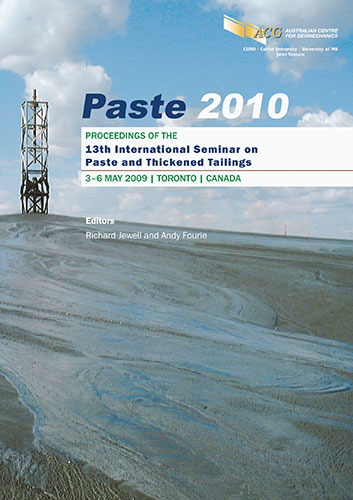Improved dewatering characteristics of uranium tailings through controlled neutralisation for paste disposal

|
Authors: Kuyucak, N; Primeau, P; Labelle, M; Palkovits, F |
DOI https://doi.org/10.36487/ACG_rep/1063_27_Kuyucak
Cite As:
Kuyucak, N, Primeau, P, Labelle, M & Palkovits, F 2010, 'Improved dewatering characteristics of uranium tailings through controlled neutralisation for paste disposal', in R Jewell & AB Fourie (eds), Paste 2010: Proceedings of the Thirteenth International Seminar on Paste and Thickened Tailings, Australian Centre for Geomechanics, Perth, pp. 311-317, https://doi.org/10.36487/ACG_rep/1063_27_Kuyucak
Abstract:
Tailings from a uranium mine have been tested to improve dewatering properties and final wt% solids of the neutralised tailings. The objectives were to maximise water recovery due to the scarcity of water in the project area and to produce a suitable cemented paste fill to minimise ore dilutions underground in order to maximise the head grade to the mill. Applicability of the controlled neutralisation process where gypsum would precipitate as crystalline particles improving dewatering properties of the tailings via deep bed paste thickeners was tested. Acid leach slurry samples used were from the end of resin-in-pulp (RIP) process after uranium recovery but before neutralisation of the slurry. The tests conducted indicated that the controlled neutralisation process greatly reduced the volume of neutralisation precipitates which typically results in a higher final density and wt% solids. Additionally it showed improved dewatering (filtration) properties. Controlled neutralisation also reduced the amount of sulphate in the solution close to that of its saturation limit, which would reduce the amount of scaling that could occur during full scale applications and would increase the recyclability of the water back to the process. Deep bed paste thickener also improved the final wt% solids of the underflow. The test work demonstrated that it was possible at the bench scale level to improve final density and recover additional water. From the final density observed as part of the current test work, without any scale up, 10 to 15% of extra water could be recovered. The increase in the filterability of the material provided a good indication that further increases in wt% solids could be obtained. Unconfined compressive strength (UCS) tests showed improvements for samples with reduced gypsum concentrations. Although further studies are required, neutralisation of uranium tailings under controlled conditions to reduce gypsum content and form gypsum as crystalline particles could provide a viable option in the preparation of suitable paste backfill materials.
References:
ASTM D4464-00 (2005) Standard Test Method for Particle Size Distribution of Catalytic Material by Laser Light
Scattering.
ASTM D854-06 (1998) Specific Gravity of Soil Solids by Water Pycnometer.
Kuyucak, N., Mikula, R.J. and Whelland, K. (1991a) Evaluation of Improved Lime Neutralization Processes Part I,
Interpretation of Properties of Lime Sludge Generated by Different Processes, In Proceedings 2nd International
Conference on the Abatement of Acidic Drainage, Vol. 2, Montreal, Quebec, Canada.
Kuyucak, N., Mikula, R.J. and Whelland, K. (1991b) Evaluation of Improved Lime Neutralization Processes Part III,
Interpretation of Properties of Lime Sludge Generated by Different Processes, In Proceedings 2nd International
Conference on the Abatement of Acidic Drainage, Vol. 2, Montreal, Quebec, Canada.
Kuyucak, N., Mattsson, E. and Bringsaas, H. (2005) Implementation of a Site-Specific High Density Sludge Process for
Treating High Strength Acid Mine Drainage at Falu Mine Site, Falun, Sweden, In Proceedings of Securing
Future, Mining and the Environment Conference, Skelefta, Sweden.
XRD Techniques for mineralogical and geochemical characterization (2009) viewed on 3 January 2009,
XRF and ICP-MS techniques for chemical analysis (2010) viewed on 3 January 2009,
Improved dewatering characteristics of uranium tailings through controlled neutralisation for paste disposal N. Kuyucak et al.
318 Paste 2010, Toronto, Canada
© Copyright 2025, Australian Centre for Geomechanics (ACG), The University of Western Australia. All rights reserved.
View copyright/legal information
Please direct any queries or error reports to repository-acg@uwa.edu.au
View copyright/legal information
Please direct any queries or error reports to repository-acg@uwa.edu.au